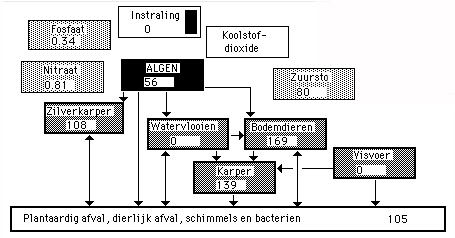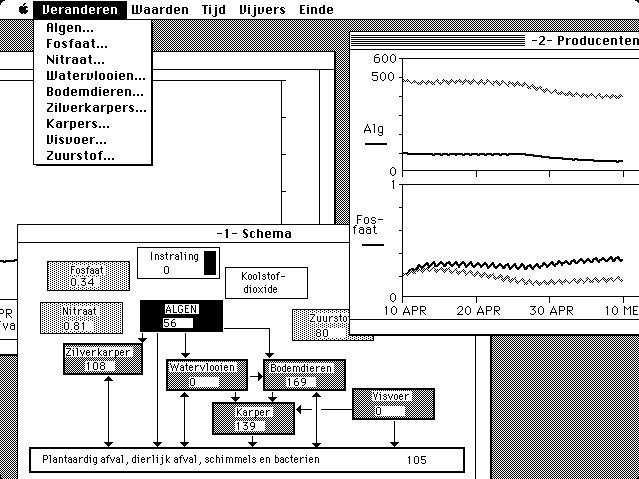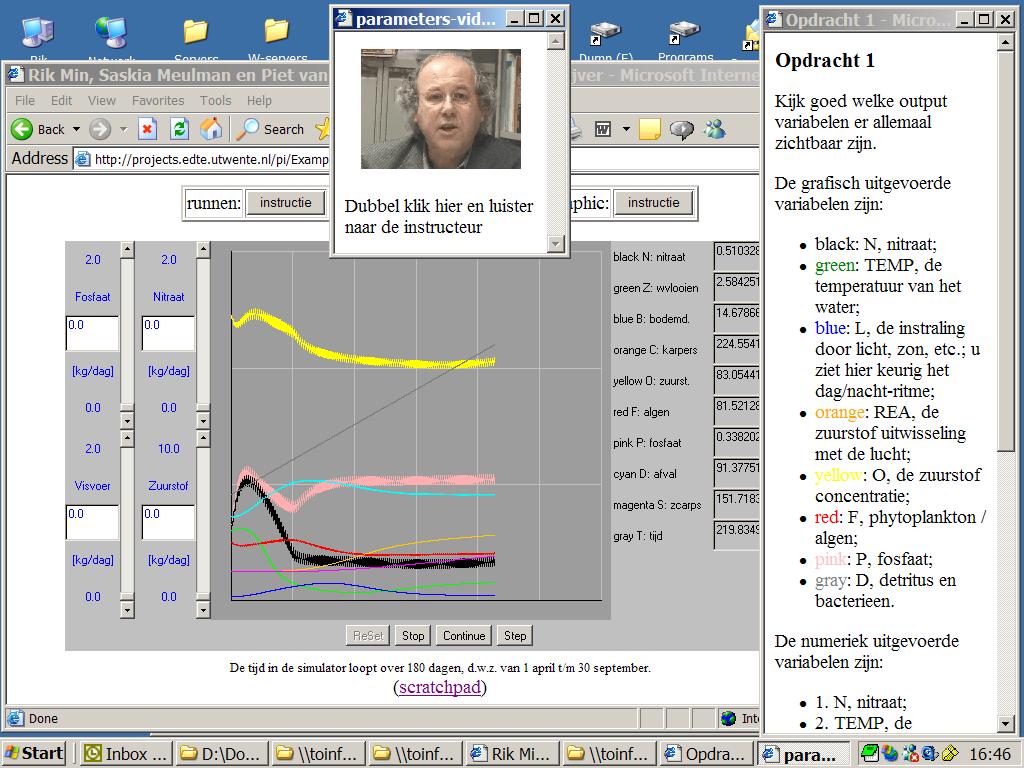
Figure 7.1 The model of the computer simulation program VIJVER. (Svirezhev, et.al., 1984)
Due to the relatively simple tropic structure a fish pond can be an excellent case for the study of the characteristics of food-chains and ecosystems in general. However, fish ponds can not be studied in the biology curriculum for practical reasons (space and time). A computer simulation program, simulating a fish pond, can be an excellent tool to overcome these problems.
For this reason a mathematical model of a fish pond can serve two purposes: fish pond management and education. The model constructed by Svirezhev et al (1984) simulates a fish breeding pond in which three fish species are present: carp, silver carp and bighead carp (see figure 7.1). Van Schaick Zillesen adapted the model for a pond in which only two fish species are present (carp and silver carp).
The program FOOD CHAIN is based on the adapted version of the model of Svirezhev et al. Svirezhev et al. (1984) give values the parameters used in their model. However, they do not give starting values for the variables of the model. Labordus (National Institute for Curriculum Development) gathered the data about the values of these variables from literature.
Educational value
The prototype VIJVER (FOOD CHAIN) is designed for students in secondary education and lower vocational training. Before the start of the simulation, students should have advance knowledge of ecological processes in the fish pond. This advance knowledge is reinforced during the use of the simulation program.

Before the start of the simulation the students should be aware of the following ecological processes:
Apart from the reinforcement of this knowledge, the program is also used to teach new phenomena like:
The prototype can simulate five ponds. In each pond oxygen, nitrate, phosphate and detritus (a complex of organic material and fungi and bacteria) are present. The following ponds can be simulated:

Figure 7.2 Input window of the computer simulation program VIJVER with the conceptual model of a fishing-pound according to Svirezhev et.al.
Pond 5 (Fish Pond). In this pond the following organisms are present: phytoplanton, zooplankton, benthos, carp and silver carp. A student studying this pond is able to feed the fish with artificial fodder. Furthermore, he or she can re-aerate the water in the pond.
The program has been used in many levels of education varying from lower vocational training to a university course.
In lower vocational training only the most simple ponds (pond 1 and pond 2) are studied. The other ponds are too complicated to be understood by the students.
In secondary education all ponds can be studied. However, ponds 2, 3 and 4 are rather similar to each other. Because of this one or two of these ponds are usually skipped.
Hartsuijker et al. (1989) developed paper materials, which can be used in combination with the simulation program. Their publication consists of the following parts:
A complete computer simulation supported learning environment can be constructed by combining the educational computer simulation program with the paper materials.
Description
The program FOOD CHAIN, version MacTHESIS, is designed by Van Schaick Zillesen, (1988) according to the description of the students' learning environment of MacTHESIS.
In this application four windows are present:
In the first window the internal structure of the simulated pond is visualized by means of a diagram. The values of the main variables are indicated in the diagram by means of digits. Day and night conditions are indicated by means of animation techniques. Students can change the values of parameters and variables in the model by clicking in the grey rectangles in the diagram. In each pond different interventions are possible:
The second window contains time registrations of the quantities of phytoplankton,
oxygen, nitrate and phosphate in the pond.
The third window contains time registrations of the quantities of carp,
silver carp, zooplankton and benthos in the pond.
The fourth window contains a time registration of the quantity of detritus
in the pond.
Students may intervene with the model by means of the input-animation
technique as described earlier. Furthermore, the same interventions are
possible by means of the menu bar.
At the start of the program pond 1 is presented to the student. The
other ponds can be selected by means of the menu bar. There is a MS.DOS
version of the program FOOD CHAIN available. Since 2001 there are some online internet versions of the program FOOD CHAIN available (see figure 7.3, 7.4 and 7.5).

Enschede, 1995; splitted & updated febr. 3, 2005. Gerestaureerd in 2020
Note: This chapter is first published by P.G. van Schaick Zillesen in his Ph.D thesis at the University of Twente, Enschede. Edited by F.B.M. Min.
Schaick Zillesen, P.G. van, and F.B.M. Min, (1988). Een R. & D. project in de onderwijskunde; een computersimulatiesysteem voor VWO en MBO. In: Onderwijskundige technologie: modellen & emperie (Red. P.H. Been & K.B. Koster) Swets & Zeitlinger, Lisse.